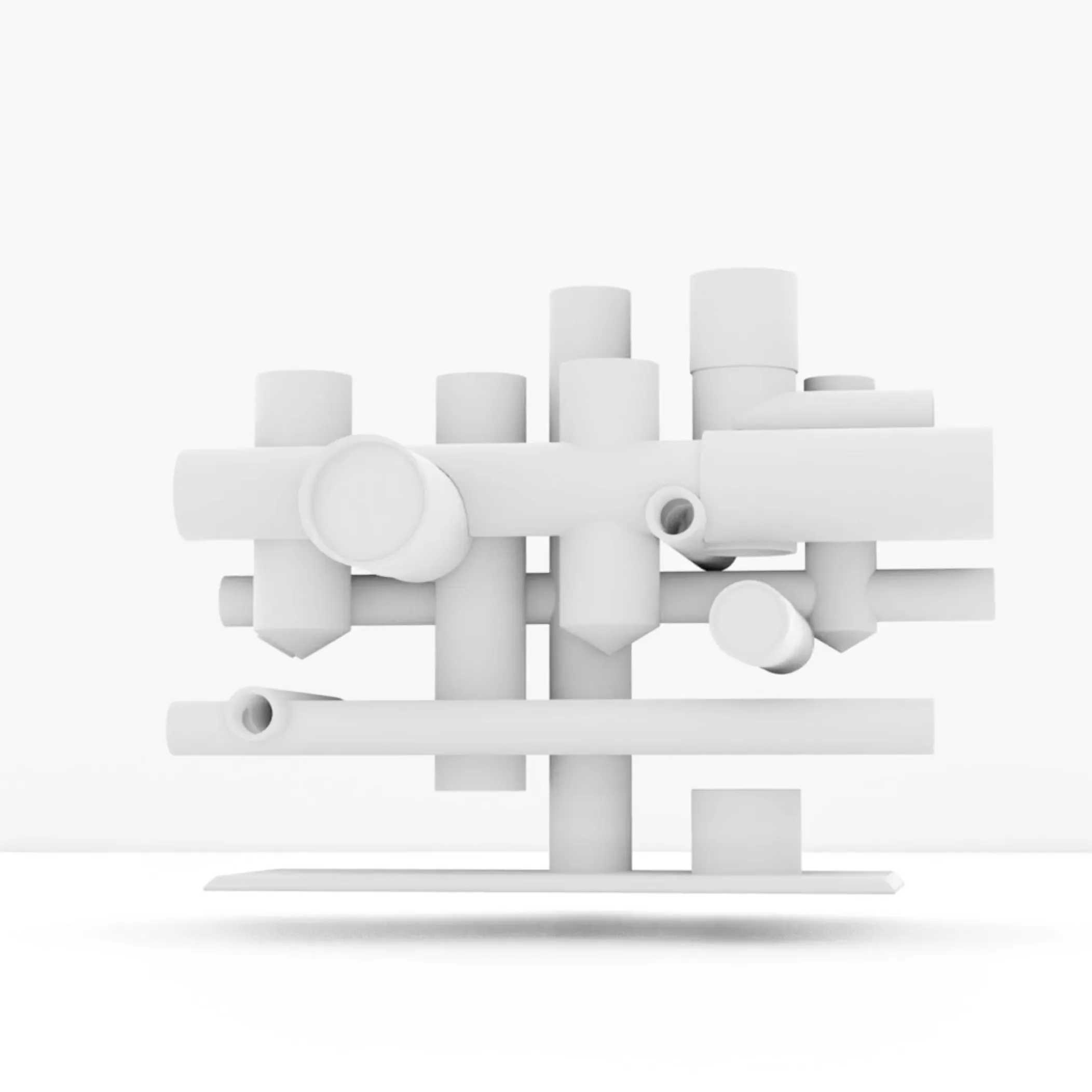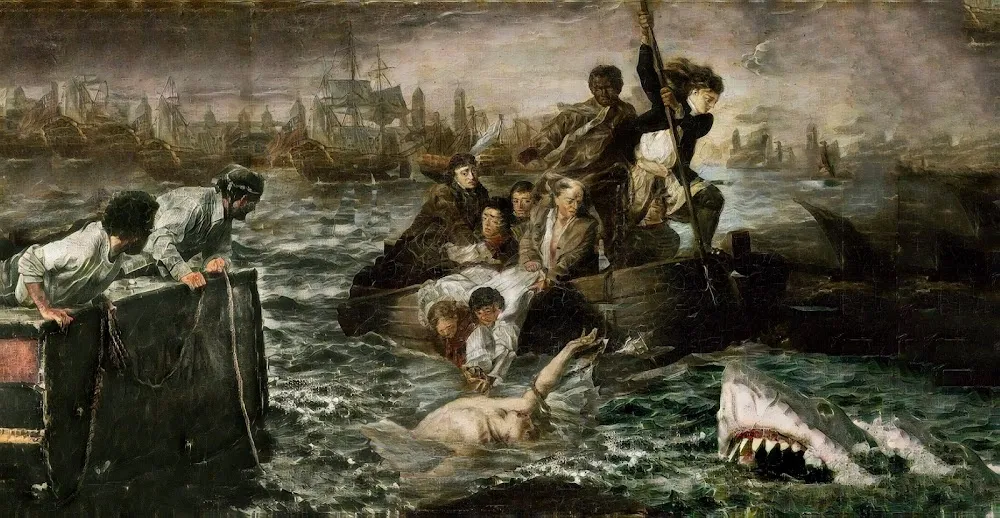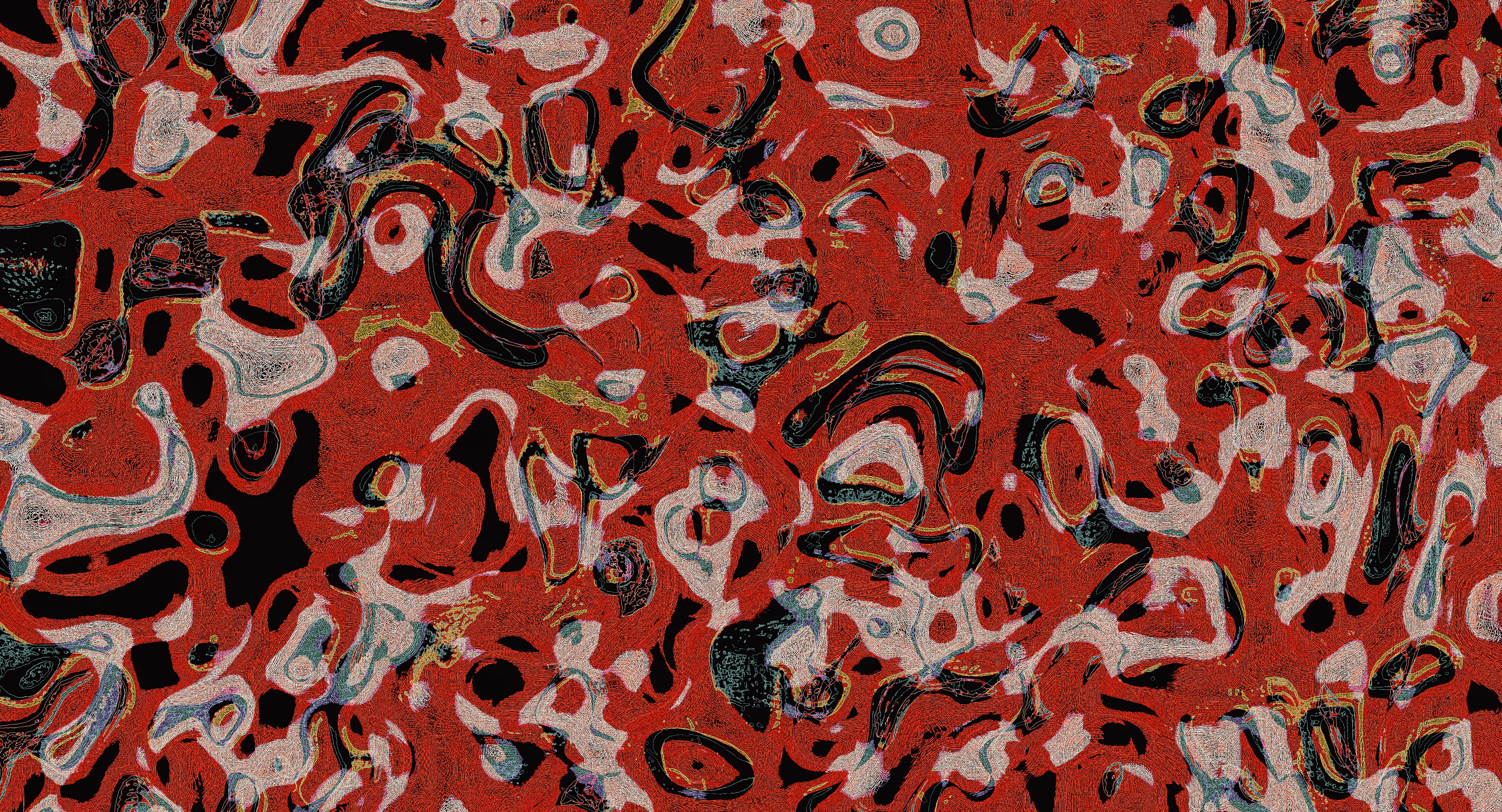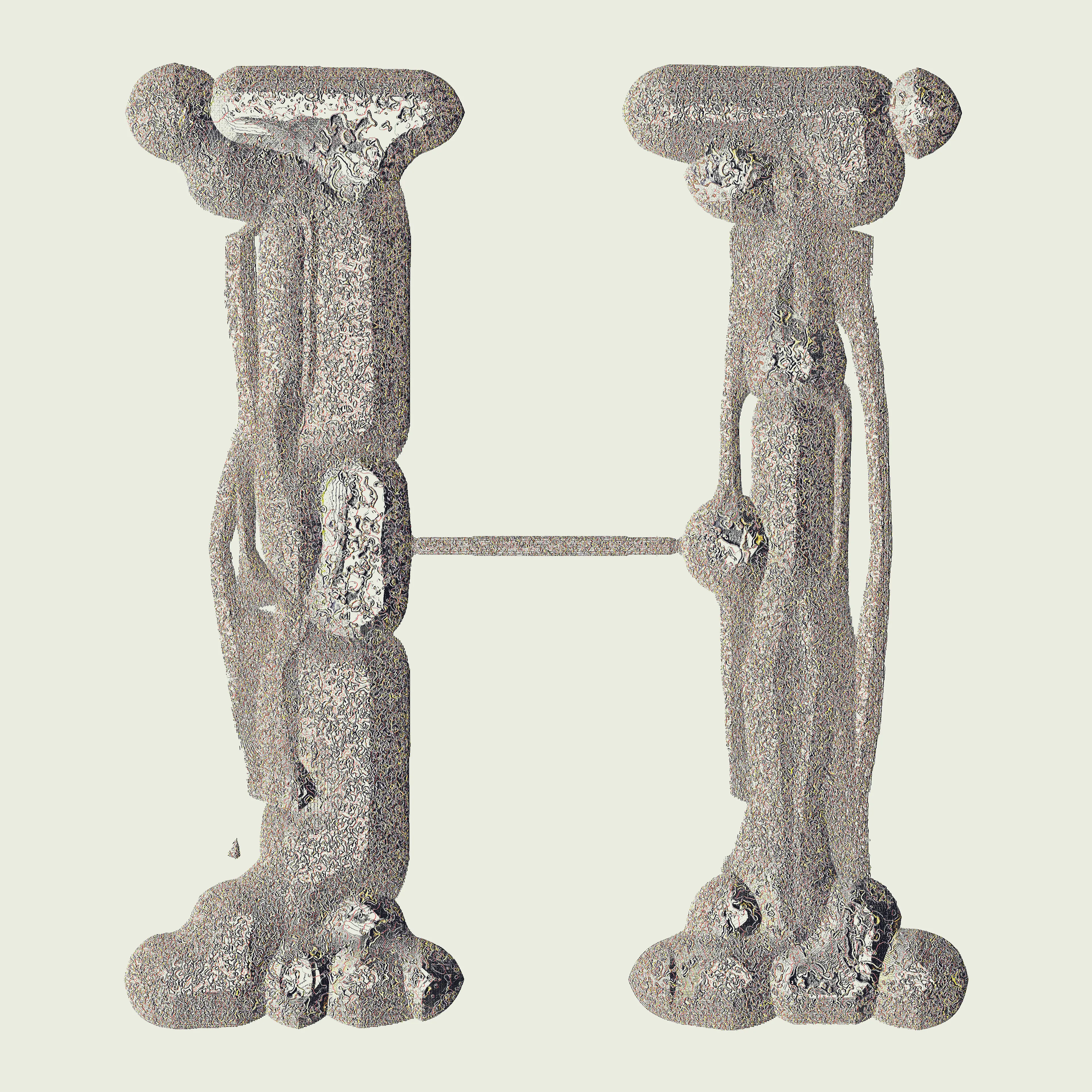Subscribe to get the latest on artists, exhibitions and more.
'Have you ever seen a dancing worm?' qubibi in conversation with Artnome

qubibi (Kazumasa Teshigawara) in conversation with Artnome (Jason Bailey), and Mimi Nguyen.
Jason Bailey: I’ve been studying and making generative/digital art for almost 25 years and I have no idea how you make your work. I can’t seem to reverse engineer it. Could you share a bit about your process and the tools you use?
Kazumasa Teshigawara: I had been a designer, so I am interested in the mechanism of how a work of art is created. When I burn white paper, a black border is formed. I am interested in something that can be created without my intention… Film burning, taking care of colors in digital… Raise the contrast and you'll get a crisp image, and eventually, you'll see the boundaries. In developing photos, even Photoshop can reproduce it, gradation, just by increasing the contrast, even though I didn't draw a line in the middle. The shapes are created at a distance from me, the lines are created where I didn't intend. When colors are in conflict with each other, boundaries are created. Boundaries become shapes. Afterimage… Very thin layers of sheets are piled up on top of each other. Time, layers of time. Transparent layers of time then some shapes emerge, forms are created, where there is the distance from me, where I don't intend them to be.
I was fascinated by such things. It is easy to reproduce this kind of effect with a program. In the meantime, I found a mechanism for the mysterious shapes by chance. Similar to the reaction-diffusion method known to everyone nowadays, but maybe not exactly the same. Zebra stripes/sea shell patterns. At the root of the creation of shapes found in nature. Something very similar to ”it” was created in 2010. I didn't know if I could call it an algorithm, for me it was ... like a mechanism. A picture that surfaces in a place I was unaware of. It had a gravitational pull on me.
I became obsessed with it.
At that stage, I was doing what is now called generative art, or graphic. In other words, there were things which I was interested in, then I was chasing them, and I naturally got on the way to it.
A while ago, Mimi asked me why I started generative art in the first place. I started creating my work which is a recent style, not because I had a passion for ”generative art” nor because I chose to do ”generative art”. I was just interested in a certain phenomenon, and as I began to create works of art, I came to realize that this is called "generative art". That's all. At that time, generative art was not as popular as it is today. Also, I was probably the only one who used this kind of expression in my work. This algorithm can be generated in real-time, using Flash, on a low-spec machine environment in 2010. And the code I wrote for it is super chaotic...😵💫
Later, I was surprised to learn that this method is similar to the Japanese lacquerware manufacturing method called Tsugaru-nuri. Paint is inserted and then it is baked in. When baked, a unique pattern emerges. It's very similar to that kind of thing. However, it's a kind of "phenomenon" at this stage. I’m dealing with a phenomenon in the program. It's not my work if it's all phenomena. Then, let's add “time”.

That's how a hello world was created, and as a result, it means that I was working on generative art. So the mechanism has a special meaning to me, it has a motive and a reason. So how far can I go with this mechanism? Or rather, other algorithms have no reason for me to do it. I've been doing it for more than 10 years.
How can I create something that "inhales" time? For others and for myself…
Mimi Nguyen: Can you tell us more about your practice? Where do you get your inspiration from?
Kazumasa Teshigawara: I think most of my inspiration was probably what I got when I was a child. It's a carpet pattern from when I lived with my mother, or a game I've been playing for a long time. Other things that seem to be inspiring right now are cycling, watching the ocean, going to festivals, watching movies, listening to music, and reading books. Very normal…
MIMIZU (みみず) was first created as a video piece in 2018, then it became a painting and then a piece of fabric. It's something that came down to me as one big theme rather than as a work of art in itself. I started the MIMIZU project at HEN (hicetnunc) in 2021, releasing an NFT of MIMIZU every few days. MIMIZU means earthworm in Japanese. I was like a worm store owner who collects beautiful worms from all over the world, and collectors who like unique MIMIZU come to his store. I was working on this project with this vision in my mind. After a year, the project was finished, but the MIMIZU itself is still a theme that lives on in my mind.
Jason Bailey: Carl Jung believed the artistic genius was one who could pluck universal symbols from the collective unconscious and manifest them as physical and tangible works of art. For me, the symbols and forms in your work come as close to consistently achieving this summoning of universal symbols as any artist I know. Where does your visual inspiration come from? Are you working largely from your subconscious similar to say the surrealists and ab ex painters or do you have a list of external visual references you are pulling from?
Kazumasa Teshigawara: I'd like to ask you a bit more about what exactly you mean. But my answer would be the former… I’m working largely from your subconscious. But where does the subconscious come from? I don't even know if it comes from inspiration or not. Sometimes, it shows up where I arrived - after a series of denials like “this is not the one” or “It doesn’t feel right”. When I feel so, I go to another place, that’s all. In creation, I never thought I wanted to do “this”. So I think I am one who doesn't have anything want to do. Well, I try to explain “this is not the one” or “It doesn’t feel right”, it is a kind of uncomfortable, skin-feeling…. perhaps it is from my childhood experiences too. It may be due to insomnia I inherited from my mother.
I often don't know when I am sleeping, but the things I see behind my eyelids when I am not sleeping, or the mushrooms, blotches, and molds that grow while I am sleeping because something woke up on its own, are my sense of beauty. Maybe.
Sometimes I let things remain wrong. Sometimes I don’t have an attachment, consequently denial either. Other times, I let it surface before it is matured. In such cases, I feel disqualified.
Mimi Nguyen: MIMIZU “leftovers”?
Jason Bailey: With “leftovers” qubibi crafts an aesthetic reminiscent of CT scans, cartography, early 1980s vector-based video games, and paintings by biomorphic twentieth-century artists like Tanguy, Arp, and Gorky.
Kazumasa Teshigawara: I think my relationship with technology started naturally through games when I was little.
Jason Bailey: I don’t like to use the word mystical to describe art but there is something universal, transcendent, mysterious, and perhaps even spiritual, in each of the forms from the series. Part of the fascination for me comes from wondering just how long the artist can go without repeating himself, the subtle diversity across dozens of works has me returning daily to follow the evolution. From a technical perspective, I have no idea how the work is created, only that it stands in stark contrast to the increasingly homogenous world of generative art. Though I’d normally probe to better understand the process behind the work this is the rare case where I am happy to let the mystery be.
Mimi Nguyen: Kazumasa-san, can you share with us more about the new project?
Kazumasa Teshigawara: The new project is “wiwizn”. I like print samples in printmaking. When you go to an exhibition of print artists, they show various attempts at color for a single work. I really want to do something like that. It is simply enjoyable to catch a glimpse of the artist's trial and error, and this blurs the boundaries of a single work of art.
Woodblock print artists test prints and experiment with different colors. At an exhibition of prints, a print in a different color may be displayed next to the artist's masterpiece. Famous works are exhibited in various colors. When looking at works printed in various colors, the boundaries become blurred and the range of viewpoints widens as the colors change, and the interpretation becomes more than one. It means people who see the work gain the artist's point of view. I was sure that this kind of aspect must be present in MIMIZU as well.
MIMIZU has been a work with strict rules (color, shape...). In the MIMIZU series, I consistently used a black screen. But it is not the same as simply making the MIMIZU colorful. I can't try to do such-and-such. Because there is no reason. What is the one thing I could do?
Then, I thought, the letters MIMIZU might be allowed to be inverted. This led me to the idea of "inverting" mimizu - wiwizn.

Mimi Nguyen: Jason, you’re the curator for qubibi’s new show. What’s the value of curation in the NFT space?
Jason Bailey: There are a lot of people who think curation is synonymous with gatekeeping. I think they are wrong. A good curator adds relevant context to an artist and their work making it more accessible, not less. Providing art historical context, biographical detail, insight into the process, and other enlightening information can change the way we experience work for the better. In this sense, curation can open gates rather than close them.
Mimi Nguyen: And lastly, Kazumasa, what are your thoughts on the future of art as digitalization progresses?
Kazumasa Teshigawara: At first, I was negative about NFTs... But I'm a super capricious and adapting person, so one day I suddenly felt like taking on a challenge, and I've been up to now. Now I'm positively and comfortably involved in NFTs, and it's refreshing to be witnessing the creation of a new form of ownership. I think that what art is all about is different for each person, but it's useless for me. Useless for what you need. And that useless thing is necessary for me to be human. What will happen as digitalization progresses... This is a desire, but I hope that nothing will change. I want it to be useless and necessary as it is.
qubibi is a digital art label by Kazumasa Teshigahara. Artist, Web Designer, and Lecturer (Tama Art University Faculty of Art and Design Department of Integrated Design) from Tokyo, Japan. qubibi has used art direction, design, and programming techniques to create various projects with on-screen media, winning numerous awards including D&AD and the Cannes Advertising Prize. In 2017, qubibi held his first solo exhibition, "the Qubibi Exhibition" at MuDA, Zurich. In 2010, qubibi released his video work "hello world", which uses a unique real-time animation algorithm. With its filmic texture and continuous temporal structure, this meditative work provides an innovative take on generative art.
Jason Bailey (Artnome) is the CEO of and cofounder of ClubNFT, a tech startup that has safely backed up thousands of NFT collections at no cost to collectors. Bailey is well known for his popular art and tech blog Artnome.com where he predicted the current NFT art explosion back in 2017. An early NFT collector and proponent of the CryptoArt movement, Bailey was the first collector on SuperRare and partnered with the marketplace to introduce the traditional art world to NFTs in 2018 at Christie's London. In 2021 Bailey founded the GreenNFTs initiative to help explore and promote eco-friendly NFT practices. Jason has written on art and tech for Art in America and the Harvard Data Science Review and has lectured at Christie’s, Sotheby’s, and top universities and institutions around the world.
Mimi Nguyen, Art + NFT at verse.works. She is a doctoral researcher and teaches at Imperial College London, Faculty of Engineering, where she leads Mana Lab, a “Future of work in Blockchain” research group, and at Central Saint Martins, University of Arts London together with CSM NFT Lab. Her previous research on creativity and human-computer interaction has been published by Cambridge University Press, Design Studies, Design Research Society, TIME magazine, and ACM Association for Computing Machinery.
Artnome had nominated the generative artist qubibi for Verse's exhibition "Have you ever seen a dancing worm?" showcasing his newest project wiwizn.
See the works in the collection wiwizn by qubibi on Verse on Friday 15 July 1PM EST | 6PM BST, where 10% of the initial sale will be donated to the Vertical Crypto Art Residency.
Jason Bailey
Jason Bailey is the CEO of and cofounder of ClubNFT, a tech startup that has safely backed up thousands of NFT collections at no cost to collectors. Bailey is well known for his popular art and tech blog Artnome.com where he predicted the current NFT art explosion back in 2017. An early NFT collector and proponent of the CryptoArt movement, Bailey was the first collector on SuperRare and partnered...
qubibi
A label by Kazumasa Teshigawara focused on Digital Art. Kazumasa Teshigawara: Artist, interaction Designer, Web Designer, Lecturer (Tama Art University Faculty of Art and Design Department of Integrated Design).
Born in Ikebukuro, Tokyo. Used to live with mother in the beginning. Later moved in with a new family. Was taken around bars while still young. Hostesses used to like me a lot. I stopped...
Mimi Nguyen
Mimi is a Creative Director at verse. She is a assistant professor at Central Saint Martins, University of Arts London where she leads the CSM NFT Lab. Her background is New Media Art, having previously studied at the Berlin University of the Arts (UdK) and Academy of Fine Arts in Warsaw. She now also teaches at Imperial College London, Faculty of Engineering, where she leads Mana Lab - a “Future...



